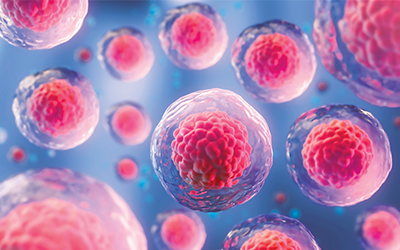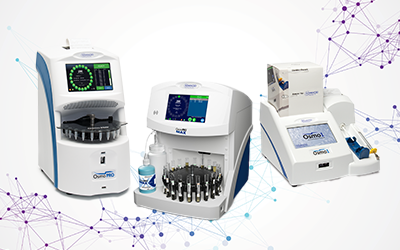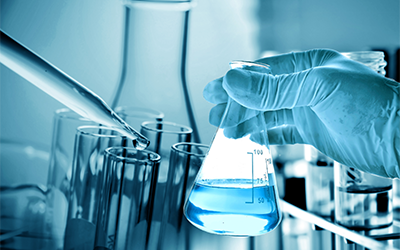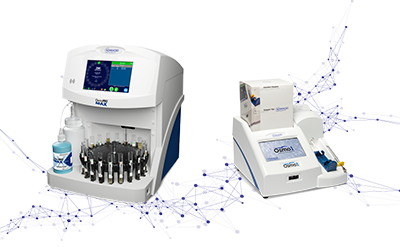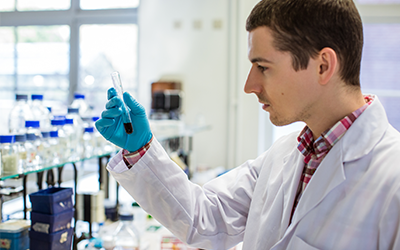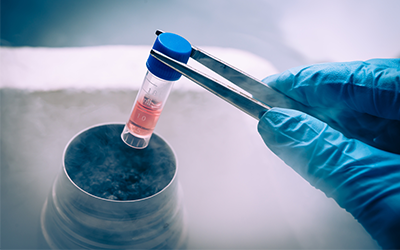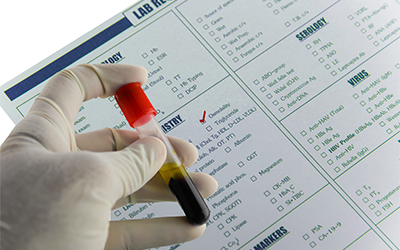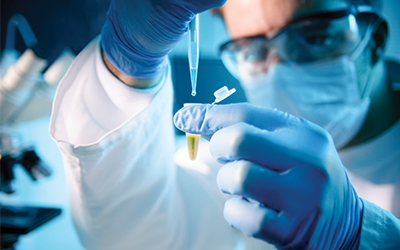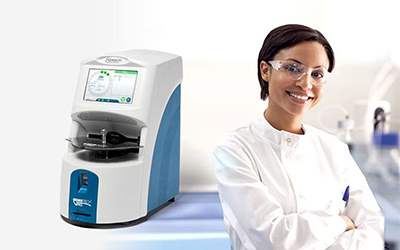Simply put, osmolality is a measurement of the total number of solutes in a liquid solution expressed in osmoles of solute particles per kilogram of solvent. When solutes are introduced in a solvent, the resulting solution differs from the initial solvent in several ways.
| COLLIGATIVE PROPERTIES |
CHANGE PER MOLE SOLUTE PER KG SOLVENT |
| Boiling Point |
Boiling Point Elevation 0.52° C |
| Freezing Point |
Freezing Point Depression 1.86° C |
| Osmotic Pressure |
Osmotic Pressure Elevation 17,000 mm Hg |
| Vapor Pressure |
Vapor Pressure Depression 0.3 mm Hg |
The resulting changes in these properties are not proportional to the weight, size or shape of the dissolved particles, but only to their molal concentration. Osmolality therefore is an ideal measurement to estimate the total concentration of solutes in a near limitless variety of liquid sample matrices, including blood, serum, plasma, urine, milk, cell culture media and almost all forms of aqueous based solutions.
Examples
For a simple chemical, such as urea, the effect is related to the total number of moles of urea in solution. For a chemical compound which can dissociate, such as sodium chloride, both the sodium and the chloride ions will contribute to these colligative properties. Therefore one mole of sodium chloride will have twice the effect as will one mole of urea. Using freezing point depression as an example:
- One mole of urea will depress the freezing point of the solution by 1.86° C
- One mole of sodium chloride NaCl (1mole Na+ + 1 mole Cl-) will depress the freezing point by 3.72° C
- One mole of calcium chloride CaCl2 (1 mole Ca++ + 2mole Cl-) will depress the freezing point by 5.58° C
- The actual mass of the particle is irrelevant, since a small molecule will exert the same effect as a large molecule.
Osmolality Equation
Osmolality is the number of Osmols of solute particles per kilogram of pure solvent. Since most ionic species do not completely dissociate, osmolality is a unit of concentration, which takes into account the dissociative effect. Osmolality is usually expressed in mOsm/kg H2O. One milliosmol (mOsm) is 10-3 osmols. The osmolality equation is:
Osmolality = ΦnC = osmol / kg H20
Where:
Φ = osmotic coefficient, which accounts for the degree of molecular dissociation
n = number of particles into which a particle can dissociate
C = molal concentration of the solution
Definitions
The following are key terms relevant to the science of osmolality and will help you to develop a better understanding of osmometry.
Avogadro’s Number: Number of molecules in one mole (gram molecular weight) of a substance. One mole of non-ionic solute (such as sucrose) dissolved in one kilogram of water will yield Avogadro’s number (6.02 x1023) of molecules. One mole of ionic solute dissolved in one kilogram of water will yield almost twice Avogadro’s number of particles.
Colligative Properties: Properties of solutions that depend on the number of particles in a given volume of solvent, not on the mass of the particles. Colligative properties include: vapor pressure, boiling point, freezing point and osmotic pressure (see also concentrative properties).
Concentration: Relative amount of solute in a solution. This can be expressed in many ways: solute to solvent, solute to solution, mass to mass, mass to volume, etc.
Concentrative Properties: When a solute is dissolved in solvent, certain properties of the solvent ―freezing point, boiling point, vapor pressure and osmotic pressure ― are changed nearly in proportion to the concentration of the solute, expressed in dissolved particles. Avogadro’s number of particles, regardless of their size or shape, when dissolved in a kilogram of water, will change each of the concentrative properties a specific amount.
Freezing Point Osmometers: Determine the osmotic strength of solution by using freezing point depression.
Freezing Point Depression: Describes the phenomenon that the freezing point of a liquid (a solvent) is depressed when another compound is added, meaning that a solution has a lower freezing point than a pure solvent.
Ionic Solution: Certain molecules, when dissolved, dissociate into charged particles called ions. A good example is sodium chloride, which dissociates in solution to sodium ions and chloride ions.
Membrane Osmometers: Measure the osmotic pressure of a solution separated by a semi-permeable membrane.
Molality: Molal concentration – grams of solute per kilogram of solvent.
Molarity: Molar concentration – grams of solute per liter of solution.
Molecular Weight: The sum of the atomic weights of all the atoms in a molecule.
Mole: Gram molecular weight, molecular weight expressed in grams. Each mole contains Avogadro’s number (6.02 x1023) of molecules. One mole of sodium chloride weighs 58.44 grams.
Non-Ionic Solution: Certain molecules, when dissolved, do not dissociate or ionize into charged particles. Good examples are glucose and urea.
Osmol: Standard unit of osmotic pressure based on a one molal concentration of an ion in a solution.
Osmolarity: Osmoles of solute per liter of solution (temperature dependent).
Osmolality: Osmoles of solute per kilogram of solvent.
Osmolality Equation: Osmolality is the number of Osmols of solute particles per kilogram of pure solvent. Since most ionic species do not completely dissociate, osmolality is a unit of concentration, which takes into account the dissociative effect. Osmolality is usually expressed in mOsm/kg H2O. One milliosmol (mOsm) is 10-3 osmols. The osmolality equation is:
Osmolality = ΦnC = osmol / kg H2O
Where:
Φ = osmotic coefficient, which accounts for the degree of molecular dissociation
n = number of particles into which a particle can dissociate
C = molal concentration of the solution
Osmotic Pressure: Hydrostatic pressure produced by a difference in concentration between solutions on the two sides of a surface such as a semi-permeable membrane.
Solutions: Homogeneous mixture of solutes in a solvent.
Solvent: Major liquid component of a solution.
Solutes: Minor components of a solution – usually solids.
Vapor Pressure Osmometers: Determine the concentration of osmotically active particles that reduce the vapor pressure of the solution.
Reference Materials
Advanced Instruments, with over 60 years of experience, is an early pioneer in the field of osmometry. During that time, we have become a trusted, valuable reference in the science of osmolality testing. We would like to share with you our collective experience with these reference materials in the hopes of further educating you on the benefits of freezing point technology.
The Physical Chemistry, Theory and Techniques of Freezing Point Determinations
This 16-page publication provides an overview of the fundamentals of the physical chemistry of solutions, useful conversion calculations, as well as freezing point theory and technique. This publication is useful for anyone operating osmometry equipment or using osmolality as a diagnostic tool. Courtesy of Advanced Instruments, Inc.
Click here for complete article
Osmometry Revisited: A Practical Guide to Its Clinical Use
This 20-page pamphlet provides a practical synopsis of the clinical uses of osmometry. It includes a useful introduction to the subject as well as summaries regarding osmolality for blood, urine, and related applications. David H. Lobdell PhD
Click here for complete article
Evaluation of Infant Rehydration Solutions
This 8-page research pamphlet provides information and suggestions in the diagnosis and treatment of infant dehydration. James Wesley M.S. Forensic Chemist, Clinical Toxicologist, Rochester, NY
Click here for complete article
Sports Hydration: ’07
Originally presented as Endurance Sports, Rehydration, Cerebral Edema and Death at NEAFS (Northeastern Association of Forensic Scientists) Annual Meeting, Rye Brook NY, November 2, 2006 James Wesley M.S. Forensic Chemist, Clinical Toxicologist, Rochester, NY
Click here for complete article
Using Osmometry: For Water-Electrolyte Balance Experiments in the Instructional Laboratory
This 14-page paper describes a number of laboratory exercises used to instruct students on principles and uses of osmometry. Includes a demonstration experiment complete with water balance calculations designed to lead the student through logical development of the volume and osmolar changes following ingestion of an osmotic load. Allen C. Norton, PhD, University of Southern California
Click here for complete article
Osmometry: The Rational Basis for Use of an Underappreciated Diagnostic Tool
A valuable clinical reference guide providing an overview of Osmometry including several case studies and an evaluation of the importance of stat osmometry in modern-day diagnostic medical applications. Robert Dufour, M.D.
Click here for complete article
Water Metabolism: Made easier
This 10-page paper discusses how physicians can better diagnose and treat disorders of hyponatremia, hypernatremia, and water diuresis, by learning and understanding the basic principles of normal water metabolism and solute balance health. The paper also includes hyponatremia case studies. Paul G. Welch M.D. Chief of Nephrology Service, Walter Reed Army Medical Service
Click here for complete article
Contact Us for Applications Support
The science of osmometry is ever expanding since 1) Osmolality is a fundamental scientific measurement and 2) The scope of technological innovation is increasing exponentially. If you have the need to determine osmolality for any application, Advanced Instruments would love the opportunity to provide you with applications support. Simply click here to provide us with your application request for support.
Interested in Advanced Instruments’ Osmometers? Click here to learn more.



